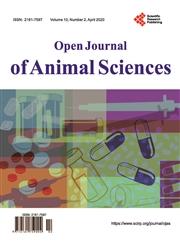In Vitro Digestibility and Gas Production from E. crus-pavonis Used in Wetlands from Domestic Wastewater Treatment
引用次数: 0
Abstract
In order to evaluate the possibilities of valorization as the feed of the plant biomass produced during wastewater treatment in constructed wetlands, a study of the in vitro digestibility and gas production of Echinochloa crus-pavonis was carried out in the Laboratory of Animal Production and Nutrition of the University of Dschang. The in vitro digestibility of Echinochloa crus-pavonis was evaluated at different harvesting periods. The digestibility parameters of E. crus-pavonis samples were determined by the in vitro method at different phenological stages. The gas production (GP) during 24 h of incubation was assessed using the in vitro incubation technique with bovine rumen fluid. In vitro dry matter digestibility (IVDM) values ranged from 52.09% to 64.76% with a decrease observed with the phenological stages of E. crus-pavonis (from 64.76% at the leafy stage to 52.09% at the flowering stage). The microbial biomass (MB) values varied significantly between 67.99 and 88.45 mg, with no significant difference observed between the leafy (88.45 mg), bolting (82.93 mg), and early heading (80.26 mg) stages (P > 0.05). On the other hand, changes in the gas produced during 24 h from the studied samples of E. crus-pavonis (34.9 and 48 ml/500mg) and volatile fatty acids (VFA) values (1.08 and 0.80 mmol/ml) decreased significantly (P E. crus-pavonis in rumen fluid significantly decreased with advanced plant maturity (P E. crus-pavonis. By combining the requirements of an optimal quantitative and qualitative production of E. crus-pavonis, harvesting at the bolting or early heading stage is an option of choice for exploitation as forage, under the conditions of this study. Based on the in vitro digestibility parameters studied, E. crus-pavonis is suitable as a ruminant feed.应用于生活污水处理湿地的克氏绿脓杆菌体外消化率及产气量研究
为了评估人工湿地废水处理过程中产生的植物生物量作为饲料的价值化可能性,在德昌大学动物生产与营养实验室对刺针草的体外消化率和产气量进行了研究。在不同收获期对帕冯刺针草的体外消化率进行了评价。采用体外法测定了不同酚期巴豆样品的消化率参数。使用牛瘤胃液体外孵育技术评估孵育24小时期间的产气量(GP)。体外干物质消化率(IVDM)值在52.09%-64.76%之间,随着巴沃尼香茅的酚期而降低(从叶期的64.76%降低到开花期的52.09%)。微生物生物量(MB)值在67.99和88.45mg之间变化显著,叶期(88.45mg)、抽薹期(82.93mg)和早穗期(80.26mg)之间没有显著差异(P>0.05),在24小时内,所研究的帕沃尼香豆样品(34.9和48 ml/500mg)产生的气体和挥发性脂肪酸(VFA)值(1.08和0.80 mmol/ml)的变化显著降低(随着植物成熟度的提高,瘤胃液中的帕沃尼斯香豆显著降低(P.crus pavonis。通过结合最佳数量和质量生产的要求,在本研究的条件下,在抽薹或抽穗早期收获是作为饲料开发的一种选择。根据研究的体外消化率参数,E.crus pavanis适合作为反刍动物饲料。
本文章由计算机程序翻译,如有差异,请以英文原文为准。
求助全文
约1分钟内获得全文
求助全文

 求助内容:
求助内容: 应助结果提醒方式:
应助结果提醒方式:


